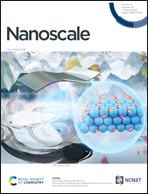Cobalt-tungsten diselenide-supported nickel foam as a battery-type positive electrode for an asymmetric supercapacitor device: comparison with various MWSe2 (M = Ni, Cu, Zn, and Mn) on the structural and capacitance characteristics†
Abstract
New exploration in nanomaterial research has been greatly encouraged so as to discover active electrode materials with extraordinary properties and performances. In this report, we demonstrated the synthesis of different transition metal-incorporated MWSe2 (M = Co, Ni, Cu, Zn, and Mn) and studied them using various characterization techniques. Subsequently, the proposed bimetallic chalcogenides were successfully applied as the active electrode materials for pseudocapacitor applications. The results of the electrochemical studies showed that CoWSe2 exhibited a higher specific capacitance of 3309.58 F g−1 at a constant applied current density of 1.35 A g−1, which is 1.07, 1.76, 2.04, 8.7, and 12.28-fold higher than that of NiWSe2, CuWSe2, ZnWSe2, MnWSe2, and pristine WSe2, respectively. The interconnected nanosheet structure with voids facilitates rich active sites for efficient electrolyte uptake and superior charge transfer during the faradaic redox reaction. In addition, the cycle stability of CoWSe2/NF was studied and the retention capacitance of about 82.1% was recorded, which is higher than that of NiWSe2 (60.4%), CuWSe2 (50.12%), ZnWSe2 (46.44%), MnWSe2 (40.12%), and pristine WSe2 (31.2%). Owing to the higher specific capacitance and cycle stability, CoWSe2 was proposed as a battery-type electrode material for the fabrication of an asymmetric device. The fabricated CoWSe2//AC device provided excellent energy density and power density of 182.54 W h kg−1 and 2810.81 W kg−1, respectively, at 3.51 A g−1. Based on these properties, the proposed research and studies can provide a way for the profound development of 2D-layered metal chalcogenides for energy storage applications.



 Please wait while we load your content...
Please wait while we load your content...